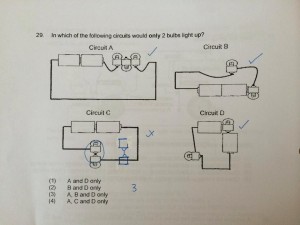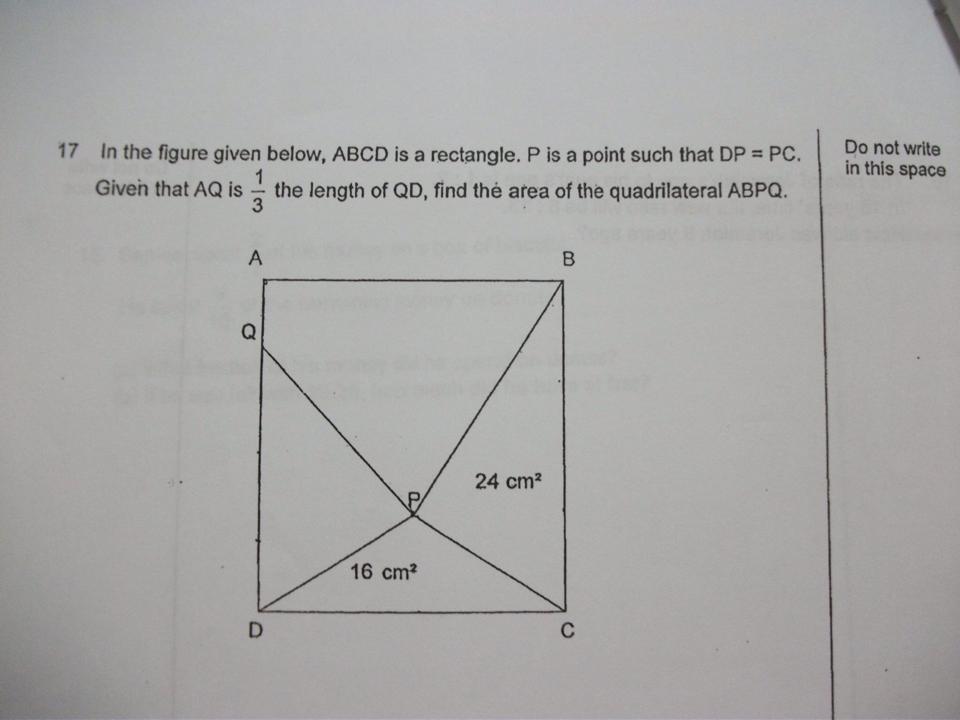As we approach the year-end examinations, we get academic queries from parents on our wall and private messages. Thought it would be great to share the questions and solutions with everyone here.
Science:
Question:

Wallace: I’ve seen this question before. It’s not a good one to be honest. There’s elastic spring force acting on the air inside the balloon – the balloon itself is elastic. But it’s not fair to say there’s elastic spring force acting on the balloon itself. But it’s debatable either way so I would say both 1 and 4 are correct.
Question: Will bulb A light up? Why?.. The right hand 2 batteries ending are facing each other which mean negative end facing each other so no current will flow thru isn’t it?.. It is a open circuit? So does circuit c light up? Both bulbs end touch each other.. Can current flow thru them? Circuit b will light up too?.. Answer shld b circuit a n d correct?


Wallace:
Two batteries facing each other will cancel. But then there is two versus one. So there will be the voltage of one battery going through the circuit.
For the second question, ACD: circuit b only has two batteries and they are facing each other. One cancel one. So no more voltage. Doesn’t have to be joined by a wire before current goes through. The bulb itself is a conductor.
 Question:
Question:
Wallace:
At first chicken to curry is 3:2. After, it’s 3:7. Since curry puffs stay the same we make the ratios so that curry puffs are the same number. We multiply the first ratio by 7 and the second by 2.
The first ratio becomes 21 : 14. The second becomes 6:14.
45 chicken pies is 15u (21 to 6). 1u is 3. There were 14u curry puffs so there were 42 curry puffs.
Question:
Difference between the 2 people in speed is 4km/h. Mary took roughly 2 hours to reach destination. Then at midpoint (which is roughly 1 hour later) the gap between them is only 200m.. shouldn’t it be around 4km difference?

Wallace:
Yes this a bad question. Don’t spend time on this. The setter probably thought the solution is at town b, the faster guy is 400m ahead. He would take 0.4/4 = 6 min to cover that distance so he would have arrived 6 minutes before the slower guy. But it’s not possible indeed.
Question: This is a Math Paper 1 question, so no calculator is to be used. What is the best approach to use to solve this question so that not too much time is used up on just this 1 question alone?

Wallace: The first statement 5/6 of the number when divided by 5 means 1/6 of the number is a whole number. Means it can be divided by 6. This is only 42,48,54,60.
42 is 7*6. 48 is 8*6 etc.
The second statement, you woek out that 2/3 of 7*6 is 7*4 since 2/3 of 6 is 4. So the numbers are 28,32,36,40. Then by elimination, you find that only 28 and 40 gives remainder of 1.
No calculator needed. In fact it takes more time with a calculator.
Question:

Wallace: We need to do two things. First thing is to express the ratios such that shaded area of Y plus shaded area of Z is the shaded area of X.
Second thing is to make sure that the total area of Y and Z is 3/4 of the total area of X.
So happens, when you multiply the ratio for X (1:6) by 2, you get 2:12. 2 is the sum of the shaded area of Y and Z without modification. 12 is also 4/3 the sum of the total area of Y and Z (4+5) = 9 = 3/4 * 12
So 1 unit = 24 (Z is 5 units, Y is 4 units)
The figure is 19 units.

Question: What approach do we use to solve this kind of Math question – part b?
The answer says find the perfect square numbers..1…4…9…16…

Wallace: Every number is a pair of multiples. Even prime numbers. For example, 5 is 1*5, 6 is 1*6 and 2*3. In other words, all numbers will be called an even number of times. So if they start sitting, they will be left sitting.
The exceptions are the perfect squares. Although they also have a pair of factors, for a perfect square one of the factors is the square root. So for example, 1 is only 1*1. And 4 is 1*4 and 2*2. So perfect squares are only called an odd number of times.
So the answer is how many perfect squares are there from 1 to 30.
Question:

Wallace:
One method is to use units and parts. This is a bit like simultaneous equations in algebra. It’s more straightforward, but maybe less easy to understand for kids. To use this method, let the number of beads Alice bought be 3u and number of stamps eve bought be 3p. Then going through the steps you’ll be able to solve for p and u.
I’ll show another method that only uses units. But it’s a little bit more complicated. First you know Alice at the end has 8:5 beads to stamps. So that’s 8u 5u.
Before she lost them. She has 8u+32 beads and 5u stamps.
So eve must have 4u+16 beads. She must also have 10u stamps before losing the 26. After she lost 26, she has 10u-26 stamps.
This is in the ratio 3:2
Cross multiply 4u+16 and 10u-26 by 3:2 you get 30u-78=8u+32.
Solving you get u =5.
Beads is 12u + 16+32=108
Question:

Wallace: F = 920
N = 528 (this is 1448 – 920)
Sold = 0.75*528 = 396 (you’re correct).
The model answer seems to solve for the non-fiction books left, which is 0.25 * 528 = 132. Which isn’t the right answer.
Question:
 Wallace:
Wallace:
This involves a bit of guess and check. First write down six numbers. X shaded. X total. Y shaded. Y total. Z shaded. Z total. This is 1 2 1 4 1 5.
Notice that shaded x plus shaded z must be equal to shaded y.
Also, total x plus total y must be 5/4 of total z. Also the shaded to total must be in the correct ratio. So to start, we try to satisfy the rule that total x plus total y is 5/4 of z. Total z is now 5.
This cannot be divided by 4.So we multiply the z ratio by 4 to give 4:20. So total of x and total of y need to sum to 25. But both are even numbers so the sum has to be even. So we multiply the z ratio by another 2 to get 8:40. Now total x and total y need to sum to 50.Let’s guess y is 10:40. Then x must be 5:10. But now we see shaded x plus shaded z is 13. This is larger than 10 which is shaded y.
So we guess again.
Say y is 12:48. Now x must be 1:2. This time shaded x plus shaded z is 9. This is less than 12!
Now we guess y is 11:44. X must be 3:6. This time shaded x plus shaded z is equal to shaded y. So the six numbers are 3 6 11 44 8 40 The fraction is 6 / 44 which is 3/22.
Question:

Wallace: Remaining books (maths and fiction) is 70%.
Maths is 15% of 70% is 10.5% Fiction is 70%-10.5%=59.5%
Difference is 882 which is 49% So total books is 1800.
Of which maths books are 189.
To find the number of maths books to buy, the number of other books is 1611. This will become 75%. So 100% is 2148.
So the number of maths books = 2148-1800=348
Question:
 Wallace:
Wallace:
They travelled the same distance and started at the same time. The speed of one is 48, the speed of the other is 36. This is 4:3
This means that 1unit (4-3) is equals to 3/4hr. This means 4 units is 3 hours.
The guy that took 3 hours went at speed 36. So distance is 36*3 = 108
The race started at 7.30am. The time taken for the last guy is 9.54am – 7.30am = ?
And you can find the speed of the last guy using distance / time.
Question:
Wallace:
30x20x24/3 = 4800ml = 4.8l
40x15x52*3/4 = 7800ml = 7.8l
tap A + 0.2l/min
tap B – 0.4l/min
at min 0, X – 4.8, Y – 7.8, difference 3L
at min 1, X – 5L, Y – 7.4L difference 2.4L each minute, the difference reduces by 0.6L.
So we need 5 minutes for the difference to reach 0 (3 / 0.6) So ans = 5
Question:
Answer:
English:
Question:
Jane is one of the girls who like/likes to eat ice cream
Tom is the only one of the boys who like/likes to play badminton
Wei:
-Jane is one of the girls who LIKE to eat ice cream. (the subject is girls- all the girls like to eat ice cream.)
– Tom is the only one of the boys who LIKES to play badminton. (referring to Tom here.)
Question:

Wei:
The preposition ‘at’ is used with adjectives to show how well someone does something. For example: I’m good at English. She is terrible at cooking. In the case which you have cited, ‘at’ should be used.
Question:
This endangered species, with fewer than 3000 in the wild, has a life ___________ of twenty to thirty years. Span or expectancy?
Wei:
When the enemies attacked, they held on/out at the fort for six weeks
Wei: hold out: to continue to defend yourself without being defeated
Question:
The poor is/are given household rebates.
Wei: ARE. Adjectives proceeded by THE and used as plural nouns take a plural verb



